Heat and twist of turbulent flows
Turbulent flow is driven by heat transport in Rayleigh-Bénard convection, and by angular velocity transport in Taylor-Couette flows. Whereas the former involves a liquid confined in a temperature gradient between a hot and a cold plate, the latter comprises a fluid confined between two concentric and independently rotating cylinders. In order to better explain many naturally occurring and industrial fluid flows, it is imperative to gain an advanced understanding of both these types of transport.
Two groups writing in Physical Review Letters reveal new results that make a step in this direction. Matthew Paoletti and Daniel Lathrop at the University of Maryland, US, and Dennis van Gils and co-workers at the University of Twente, Netherlands, simultaneously and independently measured the transport properties of Taylor-Couette flows at extremely high Reynolds numbers and reveal the transport of angular momentum between two independently rotating concentric cylinders. Paoletti and Lathrop study the interplay between shear and global rotation in the system, mimicking conditions ubiquitous in astrophysical phenomena. These results could help explain, for instance, the matter inflow towards compact objects and planetary formation. Meanwhile, van Gils et al. show that their results obey a universal scaling law that exactly resembles the ultimate scaling law for heat transport in Rayleigh-Bénard convection in the strongly turbulent regime, highlighting the analogy between these two forms of transport. – Deniz van Heijnsbergen





